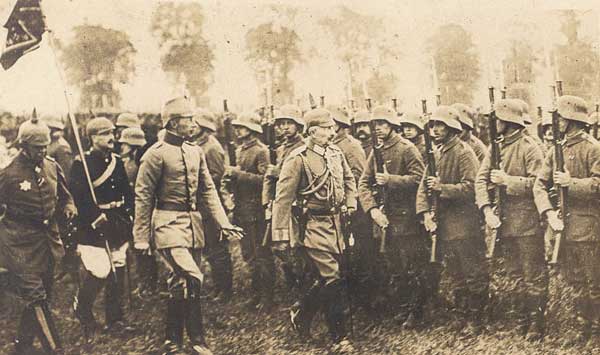
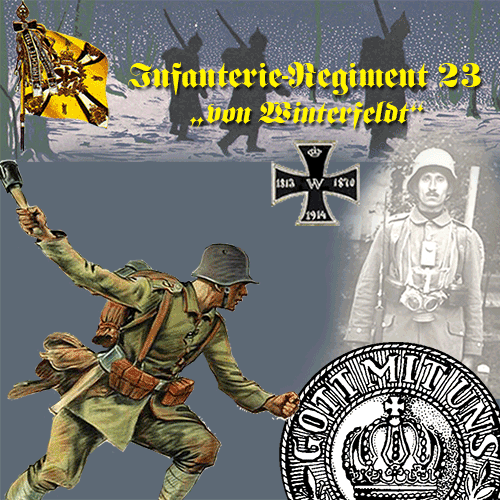
The Recreated
Infanterieregiment 23
J.R. 23 has an honored history, both the real unit and the re-created group. J.R. 23 was formally formed as a unit on January 17, 1994 with many of our members breaking away from some established but distant (at that time) units. After having been away for a number of years, the unit was re-formed in 2006 and revoted in as a GWA unit in 2011. We are a unit of the Great War Association.
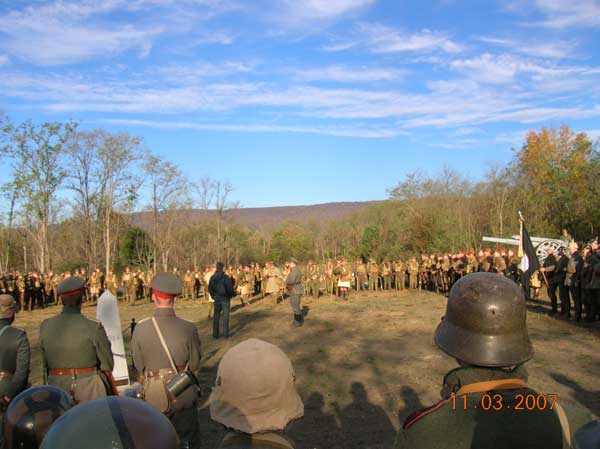
Safety meeting at the GWA Fall event, 2008
As Time Moves On
Over time, J.R. 23 became renowned for its authenticity and for leading the charge in doing things more correctly. When the Great War Historical Society (GWHS) in California was forming, their main German unit was a chapter of our group! Things were flying high with the construction of a battle site in Oklahoma, closer to where most of our members at that time lived. However, life seems to always get in the way of the best laid plans and some members couldn't make the long treks to Pennsylvania anymore, some were starting families but the one thing that seemed to dampen the fires was in 1999, one of our unit founders, Jef Fontana passed away. Jef's passing seemed to lessen some of the unit's momentum and in more recent years, J.R. 23 had stopped attending the GWA events, whilst our sister unit in California has continued on, although their events were in limbo too. Recently, the unit has been re-activated with not only some old veteran WWI reenactors, but also some new blood. We are looking to expand and recruit, making the name „von Winterfeldt“ shine again!
Where is our unit located now? Well, really, in different places... We have the following:
- 1. Kompagnie: Headquarters are in Shippensburg, PA -- about 17 miles from the GWA's battle site in Newville. This is the group who does this website, etc.
- 2. Kompagnie: Located in Oklahoma and MidWest. Does local events there, mainly in Parsons, KS.
Are you looking for a unit?
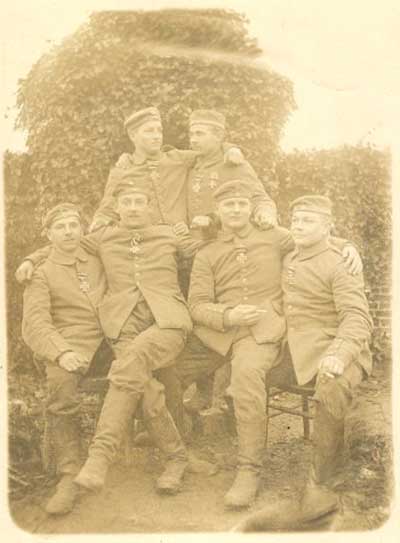 We are an authentic unit, with as much emphasis on living history as combat. We try very hard to be as authentic in our impressions as possible, with lists of required uniform and equipment items for all members, an excellent newsletter, and an emphasis on research, study, and accurate portrayal of the period. We strongly encourage everyone pitching in to help make the experience better for all. This is especially true in light of the myriad variety of equipment items that any front-line unit was equipped with, from flares or wire to Machine Guns and light mortars. Research and study is constantly required!
We are an authentic unit, with as much emphasis on living history as combat. We try very hard to be as authentic in our impressions as possible, with lists of required uniform and equipment items for all members, an excellent newsletter, and an emphasis on research, study, and accurate portrayal of the period. We strongly encourage everyone pitching in to help make the experience better for all. This is especially true in light of the myriad variety of equipment items that any front-line unit was equipped with, from flares or wire to Machine Guns and light mortars. Research and study is constantly required!
Our Goal
Our goal is to portray typical German infantrymen of the Great War, not only by accurately recreating his appearance but also researching and demonstrating his life, duties and occasional pastimes as he experienced them at and near the Front. This portrayal may be seen by the public at special events, but it is best understood and fully appreciated by unit members themselves. This is part of what we call "living history" -- the assimilation of historical knowledge by experiencing it firsthand for oneself.
What's it take?
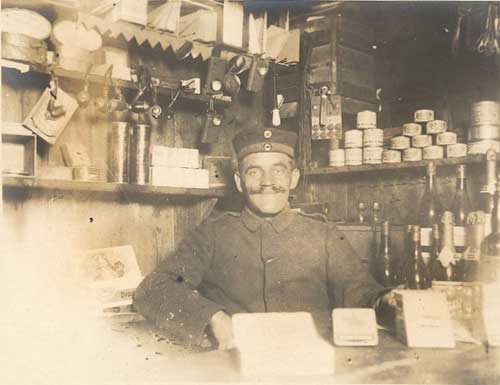 The dues are $25 per year, most of which goes to special project slike trench work and clearing.
The dues are $25 per year, most of which goes to special project slike trench work and clearing.
We publish the Die Frontsoldat Communiqué, our news magazine (which in these modern times, is published as an "E-Zine")
Great War Association dues are also needed, which include the On the Wire news letter and a place to reenact at, as well as funds to do it. The GWA, as it is known, is the umbrella organization for the hobby in the East and Mid-West (although there is a new MidWest organization), except in California (GWHS). It is strongly preferred that you be a member of the National Rifle Association of America as well.
What do we do?
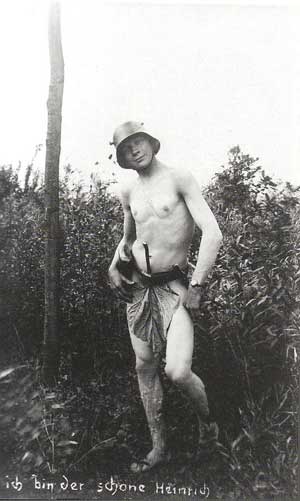 We portray the 1st Company, 1st Battalion, 23rd Imperial German Infantry Regiment „von Winterfeldt“. You’ll often see the unit name abbreviated J.R. 23, since the German script at the time made the “I” look like a “J”. Our impressions concentrate on the later war era of 1916-1918. What do we really do? Well, we go to events, both living history and battle reenactments – we also do research of things WWI that interest us. Never forget this is a hobby and it's meant to be fun. Of course, we KNOW that real German soldiers never joked around or had fun, right!?
We portray the 1st Company, 1st Battalion, 23rd Imperial German Infantry Regiment „von Winterfeldt“. You’ll often see the unit name abbreviated J.R. 23, since the German script at the time made the “I” look like a “J”. Our impressions concentrate on the later war era of 1916-1918. What do we really do? Well, we go to events, both living history and battle reenactments – we also do research of things WWI that interest us. Never forget this is a hobby and it's meant to be fun. Of course, we KNOW that real German soldiers never joked around or had fun, right!?
Who were they?
The 23rd regiment was part of the 12th division of VI army korps. It served on almost every front of the war, and saw heavy action at the Somme and the Caporetto offensive in Italy, as well as other battles. Our home area was Upper Silesia, in Prussia. The regimental barracks were in the town of Niesse, south of the army korps headquarters in Breslau. It was one of the original Silesian volunteer units of the Wars of Liberation, and has a long and rich history. It was a “titled” or named regiment -- a distinguishing honor in the Imperial army.
Uniform stuff
Other than the field-gray of the Kaiser’s army, we wear the bayonet knot for the first company, colored all white (vice the 3. Komp's yellow-white-yellow). Other than the numbered boards, there’s very few distinguishing markings for the 23rd. We portray a regular army unit of the largest army in the German Imperial forces, the Prussian Army.
For your shoulder boards, as a recruit, you’ll be loaned a pair of „Einjahr-Freiwilliger“ shoulder boards (piped with a black-white twist cord). All recruits have to wear them -- for safety reasons and so we know who to help. After attending two WWI events, the recruit is voted-on for admittance to the unit. If no member has a serious objection, recruits are then welcomed into the unit as full members and allowed to wear regular boards. The freiwilliger boards are actually property of the unit, so no one has to buy them.
Minimum kit to come out with us
Required (minimum) items for a member to have to take the field are:
- Tunic (Feldblusen, Waffenrock)
- Trousers (Hosen)
- Boots (Marschstiefel) (or shoes and puttees—Schuhe)
- Helmet (Stahlhelm)
- Shirt (Hemd)
- Neck Stock (Halsbinde)
- Soft cap (Feldmütze)
- Gasmask with can (Gasmaske)
- Canteen (Feldflasche)
- Belt and Prussian buckle (Koppel u. Koppelschloss)
- Cartridge pouches (Patronentasche)
- Breadbag and breadbag strap (Brotbeutel u. Riemen)
- Entrenching tool w/carrier (Schanzzeug)
- Mauser 98 rifle with sling (Gewehr 98)
- Bayonet (98/05 “butcher” blade type), Frog and Bayonet Knot (Seitengewehr 98/05 u. Troddel)
Items essential for living in the field (meaning that you should TRY and get them):
- Mess tin and fork/spoon combo (Kochgeschirr u. Essbesteck)
- Shelter-half/poncho (Zeltbahn)
- I.D. discs, and a Soldbuch (I.D. book) are also required.
How to get going
There are several good suppliers of uniforms and equipment, and we try to give new recruits the most help we can. We follow a mentor system, by which new recruits are paired up with full members for assistance in buying replicas and safety on the battlefield. In this manner we try to keep new recruits from getting burned by incorrect stuff or bad repops (visit the WWI Reenactor's Consumer Guide at www.reenactor-rcg.com).
Kamerad, Kommen Sie zu uns!
